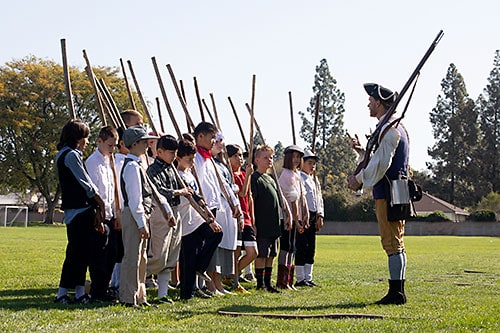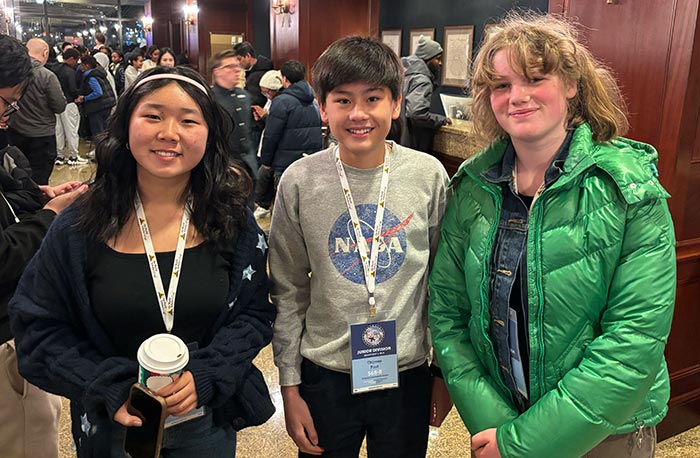Condit students, teachers bring history to life

Anyone passing by Condit Elementary School Monday morning might have done a double-take, as the play yard was filled with students and actors dressed in colonial-era garb, and a fifer was playing a period correct tune.
No, it wasn’t Little House on the Prairie day, just a newly expanded version of a longtime Condit tradition.
“We had a team of teachers that went to Colonial Williamsburg, I think it was in 1999, and brought this lesson back,” said Condit fifth-grade teacher Ellen Crawford. “And so ever since then, it’s just something that Condit fifth grade has done.”
Thanks to some motivated teachers and a generous grant, this year’s Colonial learning included Oak Glen’s Stone Soup Farm, who presented the first-ever Colonial Day to Condit’s fifth graders.
Ms. Crawford, who has been at Condit for 15 years, had always longed to participate in the Colonial Williamsburg Teacher Institute.
“And so it just happened that this last year kind of worked out as far as scheduling in the summertime.”
She and fellow fifth grade instructor Jennifer Luebbers went through a lengthy application process.
“We had to write an essay, send in a resume and a letter of recommendation from our principal,” Ms. Crawford explained. “Jennifer and I we were so excited and wanted to go so badly, we actually hand-delivered our applications to the LA County Office of Education, and then waited, waited, waited.”
A few weeks later, the good news arrived. The pair spent a week in Virginia last August, all expenses paid.
After the Virginia trip, the Condit teachers applied for a Keeping History Alive grant through Azusa Pacific University, and received $1,620, which paid for Stone Soup Farm to come and present Colonial Day to Condit’s fifth graders on March 25.
“So it’s all kind of come full circle now, and our kids got to do the stuff that we got to experience when we were in Colonial Williamsburg.”
Colonial Day included hands-on activities and interactive presentations such as writing with a quill pen, dipping candles and making colonial foods.
“Oh my gosh, it was amazing,” said fellow Condit fifth grade teacher Jenny Genovese. “In my mind I had this idea of what it’s going to look like teaching 108 kids out there on the play yard, and I’m thinking, ‘I don’t know how they’re going to organize this.’ And they did it phenomenally.”
Her students were surprised as well.
“They loved it! At the very end I had multiple students hug me as I was walking back to the classroom,” she said.
Ms. Luebbers said her students jumped at the chance to go back in time. “It was wonderful,” she said. “We had a lot of students dressing up in time period costumes, which was a lot of fun. They got to make candles and fire a musket and pretend like they were actually in a company where they had to take orders from a general. They also got to make a journey cake, where the kids measured out the ingredients and cooked over open fires on a griddle.”
Ms. Genovese was struck by the way her students marveled at some of the more simple activities, like candlemaking.
“So many of them don’t understand the background behind the candle,” she said. “Mom and dad bring it home and they’ll light them in the house, but they don’t understand the process. Seeing them hold that wick, walking around in a circle and taking turns dipping for 25 minutes or so—and all the hard work to make that, you could see the light bulbs in their mind like, ‘Oh my goodness, I had no idea this took so long to create.’”
Condit’s social studies curriculum places special emphasis on 17th and 18th-century American history with a culminating multidisciplinary unit called “Colonial Polyhedraville.”
During the six-to-eight week unit, students learn about the establishment of the English colonies in America, explore the differences between the colonial regions, examine daily domestic and working life in the colonies, and develop an understanding of the many types of people who settled in America.
The students also collaborate to establish a fictional village in an English colony, create a charter with their fellow colonists, study colonial architecture, construct colonial-style buildings, plot and plan their village design, research and report on a colonial job or trade, and finally, create a colonial-looking sign to promote their business. The students displayed their villages and signs this week at Condit’s open house.
“We’re always looking for new ways to engage and inspire our students,” Ms. Crawford said. “This has been a year in the making, and we’re very excited to see it all finally come together.”
The teachers hope to establish Colonia Day as a yearly event.
“That’s the goal,” said Ms. Luebbers. “We went all in—we bought dresses and everything! We will be definitely writing another grant next year through the same organization. Hopefully we’ll receive it again.”
—Mick Rhodes
mickrhodes@claremont-courier.com










0 Comments